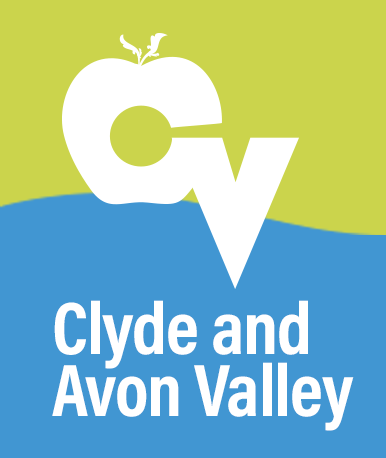I am delighted to welcome you to the Falls of Clyde. My name is Lady Geraldine Lockhart Ross and I will be your guide today. You must be tired from your train journey from Glasgow; is it not wonderful that there is now a branch line of the Caledonian Railway to Lanark?
It is unfortunate that during the Napoleonic war we were unable to go on the Grand Tour of Europe but I think the ‘petit’ tour of Great Britain allows us to appreciate our own natural wonders. Places such as Snowdonia, the Lake District and the Scottish Highlands have become celebrated destinations including this area we are in today. Did you start your ‘petit’ tour in Edinburgh? Many people do and then end their tour here with us. This picturesque landscape is an excellent place to take in the fresh Scottish air; it does wonders for one’s health, but please remember that it is dangerous to go down into the gorge.
My family, to whom the property belongs, allows ticketed access, at all hours, to the public, who find tasteful walks kept in the highest order, and seats at every fine viewpoint. My late mother, Lady Mary, implemented many improvements to the estate including many of the viewpoints and paths that you see today.
I hope you will enjoy the Falls of Clyde as much as the famous artists before you; it is such a splendid place.
Stage 1. The Archway
The archway we just passed under acted as a boundary between New Lanark and Bonnington Estate. The resident workers of New Lanark were not allowed access onto this land, although children from the village often sneaked out after school to play in the woods.
Stage 2. Dundaff Linn
Here we get our first view of the river and Dundaff Linn (Linn comes from the Gaelic meaning 'pool'). This waterfall is only 10ft high but roars down with huge ferocity after sudden downpours. There is said to be a small recess in the rocks on the Corehouse side of the river known as Wallace's Chair; William Wallace is rumoured to have concealed himself here from the English. Dorothy Wordsworth once wrote in remark to the abundance of Wallace landmarks: “How Wallace fought for Scotland, left the name of Wallace to be found, like a wild flower all over his dear Country”.
Stage 3. Mid Lodge
There were three lodges on Bonnington Estate: North Lodge (now demolished), Mid Lodge and East Lodge (outwith Falls of Clyde). Tickets were bought at North Lodge and taken by the gatekeeper here at Mid Lodge. Carriages were left and the remainder of the journey was all performed on foot.
Stage 4. Corra Linn
At an impressive 84ft, the “Clyde’s most majestic daughter” is the highest and most famous of the four waterfalls (Stonebyres Linn can be found further down the river by following the Clyde Walkway three miles from New Lanark). Turner visited Falls of Clyde in 1802 and painted a watercolour of Corra Linn. Years later he reworked this subject, creating a profound expression of the elemental forces and primary colours of nature. It shows the river as a dramatic backdrop for bathing by naked young women.
Stage 5. Corra Castle
The Bannatyne family home for 300 years, this 15th Century fortified tower house was sited overlooking the gorge for defensive purposes. The castle opposite contains an oubliette (from the French – a forgotten place); a dungeon cut into the solid rock floor. These claustrophobic cells were often used to house prisoners for unlimited periods of time.
Stage 6. Lady Mary's Well
Dorothy Wordsworth made note of this in her journals: “a beautiful spring of clear water, which we could see rise up continually, at the bottom of a round stone basin full to the brim”. Once can begin to see signs of erosion, though the sculpted fluting is still clearly visible. This feature was chosen by Lady Mary because it is equidistant between Corra Linn and Bonnington Linn. - See more at: http://clydeandavonvalley.org/trails/item/falls-of-clyde-victorian-trail#sthash.2f9tLm3Y.dpuf
Stage 7. Bonnington Linn & Island
Lady Mary commissioned the building of the cast iron bridge in front of you. It led to across to an octagonal, thatched, wooden temple (now demolished). Before the temple there was a corn-drying kiln which was used alongside a cornmill. The cornmill sadly washed away in a terrible storm. Here you can also see Bonnington Linn, it has a drop of about 30ft and is the widest of the waterfalls.
Stage 8. Bonnington Walled Garden
The walled garden was at one time full of life. The west part of the garden, closest to us, was used as a kitchen garden and at the far end was the orchard. To your left, inside of the north wall there was a glasshouse, where they grew delicious fruits in abundance. In the distance you can see Tinto Hill, the highest point in the county of Lanarkshire.
Stage 9. Hall of Mirrors
Also known as Bonnington Pavilion, it was built in 1708 as a hunting tower. It has also been a tearoom and a viewing platform for Corra Linn. There was a register here in which tourists entered the name and mirrors were placed on the ceiling so that the traveller felt as if Corra Linn were bursting over them. Dorothy Wordsworth described the reflection as “bustling like suds in a wash tub”.
Stage 10. Bonnington Sawmill
A single-storey sawmill which had a saw pit where two sawyers had to push and pull a vertical saw blade to cut wood. Later it became water-powered with the introduction of a pitchback wheel. This sawmill produced fencing materials and supplied logs for the fires in Bonnington House. The house has since been demolished but it was situated north east of the walled garden.












